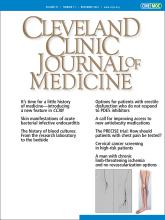A 50-year-old woman with end-stage renal disease caused by secondary amyloidosis resulting from familial Mediterranean fever had been receiving routine hemodialysis for 9 years when her arteriovenous fistula became ineffective. Efforts to create another fistula were unsuccessful, and a tunneled dialysis catheter was placed.
During a standard hemodialysis session about 5 months later, she experienced the onset of rigors, accompanied by the appearance of painless, inflamed purpuric lesions, which developed into petechiae. The petechiae were located on the nose, with a cluster at the tip of the nose, and on the legs (Figure 1). Painless, erythematous hemorrhagic lesions (Janeway lesions) and ecchymotic areas were observed on the dorsum of the hands and feet, palmar surfaces, ankles, and anterior tibial surfaces, and there were palpable purpura on the legs and painful Osler nodes on the fingers (Figure 2 and Figure 3).
Petechiae clustered on the tip of the nose.
Painless erythematous and hemorrhagic purpura and ecchymotic areas on the anterior surface of the ankle and shin.
Janeway lesions and ecchymotic areas on the palms and dorsum of the patient’s hands. Finger lesions, or Osler nodes, are typically painful.
The patient was admitted to the hospital. On examination, her temperature was 38.5°C (101.3°F). A new grade 3 systolic murmur not previously present was detected over the aorta. Laboratory testing showed a neutrophilic leukocytosis (white blood cell count 23 × 109/L [reference range 4–11], neutrophils 11 × 109/L [1.5–8.0]).
Blood cultures were obtained from the peripheral veins and catheter at 2-hour intervals, and vancomycin and ceftazidime were started empirically to cover likely causes of catheter-associated bacteremia. After 3 days of antibiotic therapy, the fever persisted, the patient developed severe headache, confusion, and lethargy, and her clinical condition deteriorated further. Diffusion-weighted magnetic resonance imaging of the brain showed diffusion restriction, areas of edema, and sharply defined bright areas in the white matter. A preliminary diagnosis of septic embolism was made.
Infective endocarditis due to metastatic catheter infection was suspected given the skin findings, newly developed systolic murmur, and catheter infection resistant to antibiotic treatment. Blood cultures grew methicillin-resistant Staphylococcus aureus, and treatment was changed according to the antibiogram results. Transesophageal echocardiogram showed a 2 × 2-cm mobile vegetation in the aortic valve.
The patient was diagnosed with acute bacterial infective endocarditis. She developed heart failure and cerebral septic embolism during follow-up and passed away in the second week after diagnosis.
SKIN MANIFESTATIONS OF INFECTIVE ENDOCARDITIS
This patient was diagnosed with acute bacterial infective endocarditis after exhibiting signs such as persistent fever, aortic murmur, and skin lesions including Janeway lesions and Osler nodes, classic skin manifestations of endocarditis.1 Our patient had 2 major criteria for the diagnosis of infective endocarditis (presence of a lesion compatible with endocarditis on echocardiography, growth of microorganisms compatible with infective endocarditis, such as S aureus, in 2 blood cultures) and 3 minor criteria (condition that predisposes to infective endocarditis [hemodialysis catheter], fever > 38°C [100.4°F], vascular phenomena [septic cerebral infarction, Janeway lesions]).2
Janeway lesions are painless erythematous or hemorrhagic lesions found on the palms and soles, while Osler nodes are painful petechial lesions found on the fingers and toes.3 Janeway lesions are more common in acute bacterial endocarditis, and Osler nodes are more often seen in subacute endocarditis.1,3
The palpable purpura on the patient’s legs were more consistent with a vasculitis process, likely secondary to the increased immune complex activation and deposition occurring in infectious endocarditis.4 The cause of Osler nodes and Janeway lesions in endocarditis remains controversial, as studies have reported different histologic findings and both positive and negative results on lesion culture.1,3 These differences may reflect the timing of biopsy, with earlier biopsy showing septic emboli with microabscess formation and later biopsy showing an inflammatory response to the microabscess and negative culture.1
DISCLOSURES
The authors report no relevant financial relationships which, in the context of their contributions, could be perceived as a potential conflict of interest.
- Copyright © 2024 The Cleveland Clinic Foundation. All Rights Reserved.









